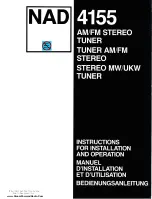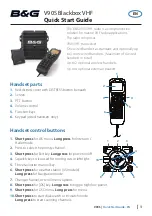
Appendix E: Glossary
- 146 -
Appendix E: Glossary
Account
The portion of a signal which contains the information identifying the location or the owner of the alarm panel. Also referred to as account number,
account code or account digits.
Acknowledgement (ACK)
(ACK) means data was received without any detected errors. (see kiss-off). A negative acknowledgement (NAK) means data was received, but there
were detected errors. An acknowledgement may be sent per packet or per alarm.
AHS
Automatic Handshake Selection. Refers to the receiver feature which enables the line card to request the handshake to be used with a particular panel
from the SG-CPM5 . The SG-CPM5 maintains a database of most recently used handshakes for all accounts connected to the receiver. Handshakes are
stored along with the phone number of the associated alarm panel.
Alarm
A message transmitted from the panel to the receiver containing account, event, zone, user or other information. There may be one or more per call. An
alarm may be repeated in the same call (if not successfully delivered in a previous attempt). An alarm will contain one or more packets. Packets can con-
tain rounds or different information. Alarm transmission is initiated with a handshake and, if received correctly, acknowledged with a kiss-off.
ANI
Automatic Number Identification.
ASCII
America Standard Code for Informational Interchange. A seven-bit alphanumeric code used extensively in data communications. Parity is often added to
the seven-bit code for error detection.
Automation
The combination of software package and PC which connects to the receiver to receive alarm events. The automation can be connected either by direct
serial connection or TCP.
Automation Message
The alarm information delivered by a receiver in a specified protocol to a central station computer or network. Also referred to as a computer message.
Block
A group of data that specifically makes up one of the elements of an alarm. For example: account block, event block, or alarm block. One packet could
contain multiple blocks.
Busy Out
A state of a line card. Under predefined criteria the line card will go off-hook so as to not process any new alarms.
C.L.A.S.S.
Custom Local Area Signaling Services. This term is used in the telephone industry to represent all features of a telephone line, such as Caller -ID, Call
Forwarding, 3-Way Calling etc.
Call
The process of a receiver going off-hook, receiving one or more alarms and returning on-hook.
Caller ID
An FSK format received by the line card. This format can be received prior to sending the handshakes. The Caller ID data can be used by the receiver to
provide additional information to all alarms received during a call.
Capture
The ability of a receiver to store commands sent to the panel from the automation computer after all of the alarms have been sent from the panel to the
receiver.
Содержание System Five
Страница 6: ...1 0 Table of Contents 6...
Страница 76: ...6 0 Options 76 FIGURE 6 3 Flow diagram for Fallback Mode 1...
Страница 77: ...6 0 Options 77 FIGURE 6 4 Flow diagram for All Mode 2...
Страница 78: ...6 0 Options 78 FIGURE 6 5 Flow diagram for IP Fallback Mode 3...
Страница 154: ......










































